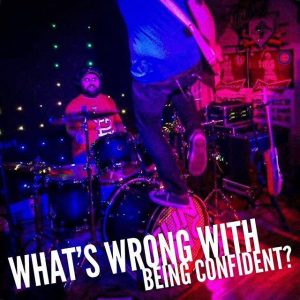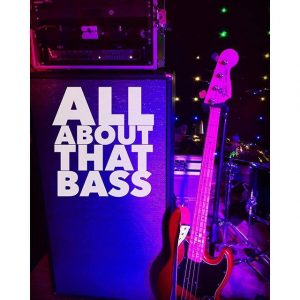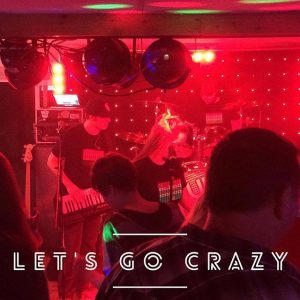Versatile Gear Talk – Bass Guitar
Posted by Fun DMC on April 30th 2016

Earlier this week, Robert did a breakdown of his guitar rig. As the bass guitar player, there’s a lot less that I need to deliver in terms of tone to match up to the original artist for our songs. If a guitarist isn’t using a good delay on a song like Shut Up And Dance With Me or that sweet chorus effect on Under The Bridge, it will be noticeable to most people. They may not notice what exactly sounds off, but they’ll know something isn’t right. Whereas, for a cover band that specializes in pop, rock, and dance material from the last few decades, there isn’t much of a variety of tone that I have to be concerned about.
 That said, there are some things that I took heavily into consideration when building the appropriate rig for Fun DMC. When Robert and I were in Closing Time, we ran everything directly to the board and let our sound operator control our volumes. Since we were using in-ear monitors (and still do!), having the guitar and bass go without an amp was definitely convenient in keeping our overall volume managed. However, it always felt like we were missing a lot of that live stage energy that came with having our instruments heard behind us alongside the drums. It certainly was noticeable the few times we did use a bass amp. So when we put together Fun DMC, we decided to use live amps to help heighten that stage energy we are proud of.
That said, there are some things that I took heavily into consideration when building the appropriate rig for Fun DMC. When Robert and I were in Closing Time, we ran everything directly to the board and let our sound operator control our volumes. Since we were using in-ear monitors (and still do!), having the guitar and bass go without an amp was definitely convenient in keeping our overall volume managed. However, it always felt like we were missing a lot of that live stage energy that came with having our instruments heard behind us alongside the drums. It certainly was noticeable the few times we did use a bass amp. So when we put together Fun DMC, we decided to use live amps to help heighten that stage energy we are proud of.
The Bass Amp
 While we are very, very good at keeping our volume at a appreciated level, I wanted to have a tone that provided a good live *thump* out of my cabinet while on stage. Matched with a balanced kick drum, it helps get that feeling in the chest when the bass hits and also doesn’t require us to push our overall low-end volume all that hard. Ever since I started playing bass, I’ve loved the tone of an Ampeg. I’ve dabbled with other amp/cabinet combos over the years, but always go back to this standard. I started with Fun DMC on a 2×10 cabinet, but have since moved up to an 8×10. Admittedly, it doesn’t change the sound one bit, but looks awesome on stage. I have this paired with a 1000 watt Ampeg SVT7 power amp, which is just the right amount of power to be able to get the sound I want.
While we are very, very good at keeping our volume at a appreciated level, I wanted to have a tone that provided a good live *thump* out of my cabinet while on stage. Matched with a balanced kick drum, it helps get that feeling in the chest when the bass hits and also doesn’t require us to push our overall low-end volume all that hard. Ever since I started playing bass, I’ve loved the tone of an Ampeg. I’ve dabbled with other amp/cabinet combos over the years, but always go back to this standard. I started with Fun DMC on a 2×10 cabinet, but have since moved up to an 8×10. Admittedly, it doesn’t change the sound one bit, but looks awesome on stage. I have this paired with a 1000 watt Ampeg SVT7 power amp, which is just the right amount of power to be able to get the sound I want.
I generally keep my EQ at an 1:00 position for lows and highs and an 11:00 for the mids. This even tone helps the bass fit in to a variety of genres – from 80s to current to hard rock to dance. It also colors well when adding some fuzz on top of it, which I’ll talk about in a minute.
The Pedal Board
Most bassists aren’t huge pedal guys. For awhile, I ran a pedal board to the front of the stage, but found myself barely using the effects. Certainly not enough to warrant carrying it all around in a separate case and running a bunch of cables. So I made the decision to move all of the pedals into my amp rack on a rolling shelf. This allowed me to quickly access all of them for when I need them, keep them permanently wired together, and everything can be tucked away when not in use. It was also one less case to transport. Coupled with a drawer and a power conditioner, I was in business. Then there are the pedals themselves:
Shure Wireless Unit w/ built in tuner – like Robert mentioned, I never thought a wireless unit would be a necessary accessory, but I can’t imagine going without it now. Him and I moved to these at the same time and it really made a difference with being able to engage with the audience.
Boss SYB-5 Bass Synth – this is a multi-effect bass synth pedal. It’s a bit touchy, but with the envelope filter and blended lightly, it makes a great addition for a lot of the dance songs like Can’t Stop The Feeling or the bridge to Hey Ya.
Electro Harmonix Big Muff Pi – while I originally bought this amazing fuzz pedal years ago for guitar, once I tried it on bass, I was hooked. One of my biggest influences is Ben Folds Five and this pedal was instrumental (ha) in Robert Sledge’s bass tone. I crank up the tone on it to get the distortion for songs like Umbrella/Uprising and the turnarounds for Don’t Stop The Sandman.
Boss LS-2 Line Selector – A recent addition, I use this to quickly switch between bass and keytar.
The Bass Guitar
I started off in Fun DMC playing my favorite bass – my 1976 Fender Telecaster Bass. I’ve had this since I first started playing when I was a teenager and it has a lot of sentimental and personal value to me. The low end is unreal and definitely lends itself to a rock sound. Unfortunately, over the years of using it, it’s started to get a little worn and I found that I really needed a more even tone for a lot of the newer music we were doing. Enter a Fender Standard American Jazz by way of Linda’s Music in Decatur, Illinois. It sounds wonderful, has great action, and is noticeably lighter than the Tele bass. So that has become my standard bass while I eventually refinish the Telecaster.
The Keytar
 Previously, I was the keyboardist/rhythm guitarist for Fun DMC until Brian stepped down and I moved over. A really fun moment in our set was when I would strap on my Alesis Vortex keytar and have an opportunity interact cord-free. It always went over well with the audience and provided a unique touch to our act. Recently, with the introduction of some new songs with a heavy synth-bass, I thought it might be a good opportunity to reintroduce the keytar in a new way. I use it on songs like Confident Uprising and Moves Like Jagger to provide that low synth bass tone and can have a lot of freedom since I’m not tethered to a keyboard stand. I run it through my Macbook via MIDI running Ableton Live and then it outputs to the Line Selector to go out to the direct box and feeds out of my amp just like the bass.
Previously, I was the keyboardist/rhythm guitarist for Fun DMC until Brian stepped down and I moved over. A really fun moment in our set was when I would strap on my Alesis Vortex keytar and have an opportunity interact cord-free. It always went over well with the audience and provided a unique touch to our act. Recently, with the introduction of some new songs with a heavy synth-bass, I thought it might be a good opportunity to reintroduce the keytar in a new way. I use it on songs like Confident Uprising and Moves Like Jagger to provide that low synth bass tone and can have a lot of freedom since I’m not tethered to a keyboard stand. I run it through my Macbook via MIDI running Ableton Live and then it outputs to the Line Selector to go out to the direct box and feeds out of my amp just like the bass.
